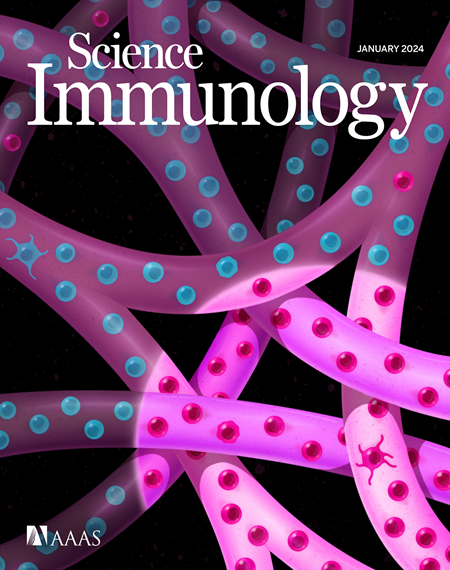Multimodal delineation of a layer of effector function among exhausted CD8 T cells in tumors
IF 16.3
1区 医学
Q1 IMMUNOLOGY
引用次数: 0
Abstract
Undescribed functional axes may intersect with the trajectory of T cell exhaustion (TEX) to contribute to the antitumoral functions of CD8 T cells. By leveraging fluorescent transcriptional reporting of the T cell activation marker Cd69, we defined a classifier for potent versus suboptimal CD69+ activation states arising from T cell stimulation. In tumors, this delineation provided an additional functional readout among TEX subsets, marked by enhanced effector molecule production. The more potent Cd69-TFPhi state was the most prominent in a T cell–mediated tumor clearance model, displaying increased engagement and superior tumor cell killing. Simultaneous analysis of gene and protein expression in human head and neck tumors enabled a similar strategy to identify Cd69RNAhiCD69+ cells with enhanced functional features compared with Cd69RNAloCD69+ cells among intratumoral CD8 T cell subsets. Thus, refining the T cell functional landscape in tumors potentiates the identification of rare, potent effectors that could be leveraged for improving cancer treatment.
肿瘤中耗尽的CD8 T细胞中效应功能层的多模态描述
未描述的功能轴可能与T细胞衰竭(T EX)的轨迹相交,从而有助于CD8 T细胞的抗肿瘤功能。通过利用T细胞激活标记Cd69的荧光转录报告,我们定义了T细胞刺激引起的有效和次优Cd69 +激活状态的分类器。在肿瘤中,这种描述提供了T - EX亚群的额外功能读数,以增强的效应分子产生为标志。更有效的Cd69 -TFP hi状态在T细胞介导的肿瘤清除模型中最为突出,显示出增加的接合和更好的肿瘤细胞杀伤。同时分析人类头颈部肿瘤中的基因和蛋白表达,可以采用类似的策略在肿瘤内CD8 T细胞亚群中鉴定出与Cd69 RNA低Cd69 +细胞相比具有增强功能特征的Cd69 RNA高Cd69 +细胞。因此,完善肿瘤中T细胞的功能景观,加强了对罕见的、有效的效应物的识别,这些效应物可以用于改善癌症治疗。
本文章由计算机程序翻译,如有差异,请以英文原文为准。
求助全文
约1分钟内获得全文
求助全文
来源期刊

Science Immunology
Immunology and Microbiology-Immunology
CiteScore
32.90
自引率
2.00%
发文量
183
期刊介绍:
Science Immunology is a peer-reviewed journal that publishes original research articles in the field of immunology. The journal encourages the submission of research findings from all areas of immunology, including studies on innate and adaptive immunity, immune cell development and differentiation, immunogenomics, systems immunology, structural immunology, antigen presentation, immunometabolism, and mucosal immunology. Additionally, the journal covers research on immune contributions to health and disease, such as host defense, inflammation, cancer immunology, autoimmunity, allergy, transplantation, and immunodeficiency. Science Immunology maintains the same high-quality standard as other journals in the Science family and aims to facilitate understanding of the immune system by showcasing innovative advances in immunology research from all organisms and model systems, including humans.
 求助内容:
求助内容: 应助结果提醒方式:
应助结果提醒方式:


